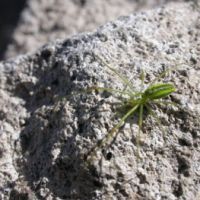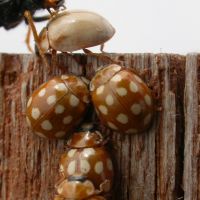As I approached the top of Mount Tarumae's western peak, located in Hokkaido's Shikotsu-Toya National Park, for a brief moment I thought an early reward was awaiting me in the form of clusters of ripe blueberries in the bush tops. At first glance it appeared that the bushes were in fruit, and it was only on close inspection that I realized just how much hungrier I would have to be to enjoy that mountaintop snack — they were not fruit, they were beetles!
The sight of summit cairns and summit posts in Japan peppered with insects of many kinds is not an unusual one for those who enjoy mountain hiking, but bush tops adorned with so many beetles was a new experience for me. The sudden increase in insect density and diversity on mountaintops is something that I have remarked on before in this column (August 2011), and this high life presents a hint at what is happening in the air around us that we so easily assume is "empty."
Narrow-winged Pacific Swifts, rushing across a seemingly vacant sky over Japan's high mountains, seem to be jet-powered by their own high-pitched screams. In a whoosh and a shriek, like an attenuated aerial exclamation, they hurtle, black clad and ominous, dealing out death in the strangest of high-altitude fashions. Mouths wide open, and ringed with rictal bristles forming an extended net, the sickle-winged swifts scoop up high-flying or windswept insect life from the air, like a baleen whale gulps in and sieves plankton from the ocean. In a scream, a whoosh and a gulp, another mouthful meets its maker.
The swifts, fueled by this strange aerial smorgasbord, spend almost their entire lives on the wing high above the ground in an airborne realm almost beyond our imagination. So astonishingly well adapted are they to their aerialist lifestyle that even their brief copulatory exertions are performed in flight. Chittering cries end in zipping screams as pairs of swifts tear across the sky and, very briefly, their black crescent shapes merge.
At high speed they maneuver with precision: The male raises his wings in a shallow V, the female depresses hers in a shallowly inverted V and for a moment, as the two meet and consummate their bond, they resemble an X-wing fighter from "Star Wars" at full throttle. Then, in the blink of an eye, they break apart and resume their aerial food chase in the "thin zone."
At the other end of the world from Japan, I recall strolling one early morning beside a meadow on the Falkland Islands in the South Atlantic low morning sunlight glinting off gossamer threads of spider silk; it seemed a magical world of light and fibers. As I leaned in to look closer at the microcosm unravelling beneath me I found tiny spiderlings had clambered to the tips of grass stems and were reeling out thin lines of webbing from their spinnerets in readiness for "ballooning." As the breeze shifted, as their draglines lengthened into taut kite strings and were picked up by the wind, one by one they were lifted off, and borne aloft into the eddies and currents that made up the air around me.
Ballooning spiders and hurtling swifts are just a hint at the vast aero-fauna that wafts or swoops around us. For the most part, think microscopic: Think of spores from some 40,000 species of fungi, of 1,000 or more species of bacteria, of viruses, and the spores of thousands of moss and liverwort species. Consider tiny seeds and small arthropods (spiders and insects); these form part of what is known as aeolian plankton, or aeroplankton.
The association between water and plankton, microscopic and macroscopic organisms or their larval stages and minute plant and algal life adrift in the oceanic currents or living in freshwater, is such a powerful one that it is hard at first to grasp the concept of this extending into the air around us. If you suffer from hay fever, however, you'll have an immediate understanding of airborne plankton, as you have direct experience of it and its impact on your eyes and nose. All manner of things may be whisked up into the air around us, depending on the wind's strength, and this aeolian plankton is both a blessing and a curse for us humans.
Each spring, the gathering yellow patina that collects on my balconies and windows is an indication that winter has ended in the Gobi and Taklamakan deserts of Central Asia, and that fine loess dust from that immense arid region has been swept along and up into the atmosphere as the land thaws and the winds blow. The same material falls in a fine rain of yellow dust across the Korean Peninsula and the Japanese Archipelago, and regularly spans the Pacific Ocean reaching the Hawaiian Islands and beyond that to Canada and Alaska.
During extreme dust-storm events, so severe that they may reduce visibility so much as to force the closure of airports in China, extended periods of strong wind are known to have moved dust on an astounding journey of more than 20,000 km across Asia, the North Pacific, North America and the North Atlantic, only to be found in deposits high in the French Alps!
Airborne dust, sucked up into the atmosphere over the Sahel and Sahara of northwest Africa, is measured in millions of metric tons and prevailing winds in that part of the world blow it westwards so that it rains out over the Atlantic, effectively fertilizing that ocean, though the amount of fallout decreases the further west the wind carries it. Nevertheless, despite the long-distance fallout track spanning across the whole of the Atlantic, sufficient dust remains airborne for it to trickle in a steady rain over the immense green vegetational blanket of the Amazon basin in the interior of Brazil, and provide that region with vital minerals. A shift in the wind takes this fine desert dust northwards across the Mediterranean and into Europe reaching, on occasion, even the British Isles.
Not only do air currents and wind events whisk surface dust high into the air, but they also bear weak-flying insects and spiders into the atmosphere, something in which the American aviator Charles Lindbergh (1902-1974) took interest by holding sticky slides outside his cockpit while crossing the Atlantic. Lindbergh's simple experiment netted "a mixture of pollen, volcanic ash, algae, diatoms and insect parts" and that was at altitudes of up to 3.7 km. Aeolian plankton is adrift at altitudes measured in tens, hundreds and thousands of meters. Later experimentation with more sophisticated sampling equipment over the Pacific has indicated that the 1.7 billion cu. km of air over that ocean may at any one time hold aloft a cloud of some 85 billion insects!
A walk across a snowy landscape in winter, or across a high montane snowfield in summer, reveals some of the arthropod fallout from the "aeroscape" above us, as insects and arachnids of various kinds can be found chilled and barely mobile on the snow surface having "rained out" from the aeolian plankton.
Similar finds are equally possible on montane glaciers, on Arctic ice floes and Antarctic ice sheets. But there is no need to travel to exotic places to witness life in the air. A freshly swept high-rise balcony provides a similar blank "canvas" and the perfect backdrop against which to spot the dust, spores and tiny creatures of this extraordinary aerial ecosystem.
Mark Brazil, naturalist and author, has written Wild Watch for 30 years, and as the founder of Japan Nature Guides, he also organizes and leads wildlife, birding and photo excursions around Japan. His latest book, "Field Guide to the Birds of East Asia," and his earlier "A Birdwatcher's Guide to Japan" and "The Birds of Japan" are available at good bookstores, or directly from the author via [email protected] or www.wildwatchjapan.com.




















With your current subscription plan you can comment on stories. However, before writing your first comment, please create a display name in the Profile section of your subscriber account page.